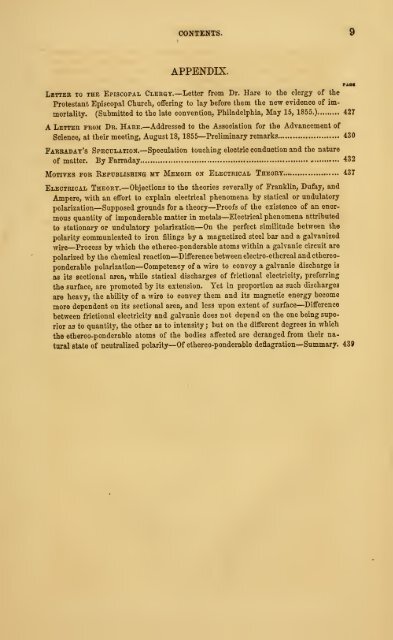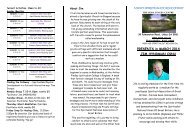- Page 2: BOSTON PUBLIC LIBRARY
- Page 10: Entered according to act of Congres
- Page 16: PLATE II. Description of the instru
- Page 21: H ft
- Page 27 and 28: CONTENTS. Preface.—Letter from J.
- Page 29: — CONTENTS. 7 comparatively with
- Page 35 and 36: PREFACE. As prefatory to this volum
- Page 37 and 38: : PREFACE. 13 Author s Reply to the
- Page 39 and 40: PREFACE. 15 I sincerely believe tha
- Page 41 and 42: — — — INTRODUCTION. As introd
- Page 43 and 44: : ; INTRODUCTION. ly To man it seem
- Page 45 and 46: INTRODUCTION. 21 25. I have no doub
- Page 47 and 48: INTRODUCTION. 23 these inventions a
- Page 49 and 50: — INTRODUCTION. 25 53. In like ma
- Page 51 and 52: : ; INTRODUCTION. 27 the first plac
- Page 53 and 54: ; INTRODUCTION. 29 his manhood. If
- Page 55 and 56: ! ; ;! INTRODUCTION. 31 Runs to eac
- Page 57 and 58: INTRODUCTION. 33 111. Nevertheless,
- Page 60 and 61: y^^c^^c . ^
- Page 62 and 63: 36 INTUITIVE EVIDENCE OF 125. "Insu
- Page 64 and 65: 38 INTUITIVE EVIDENCE OF contemplat
- Page 66 and 67: 40 INTUITIVE EVIDENCE OP 149. But a
- Page 68 and 69: 42 INTUITIVE EVIDENCE OF occasional
- Page 70 and 71: ; 44 INTUITIVE EVIDENCE OF 175. The
- Page 72 and 73: 46 INTUITIVE EVIDENCE OP chanism co
- Page 74 and 75: 48 INTUITIVE EVIDENCE OF placed the
- Page 76 and 77: ; : 50 INTUITIVE EVIDENCE OF as per
- Page 78 and 79: 52 INTUITIVE EVIDENCE OF 227. In on
- Page 80 and 81:
— 54 INTUITIVE EVIDENCE OP any ps
- Page 82 and 83:
56 CORROBORATIVE EVIDENCE OF obtain
- Page 84 and 85:
58 CORROBORATIVE EVIDENCE OP fourth
- Page 86 and 87:
60 CORROBORATIVE EVIDENCE OF 276. M
- Page 88 and 89:
a 62 CORROBORATIVE EVIDENCE OP of e
- Page 90 and 91:
— 64 CORROBORATIVE EVIDENCE OP ho
- Page 92 and 93:
66 FOREIGN CORROBORATIVE EVIDENCE O
- Page 94 and 95:
; 68 FOREIGN CORROBORATIVE EVIDENCE
- Page 96 and 97:
70 FOREIGN CORROBORATIVE EVIDENCE O
- Page 98 and 99:
: : 72 FOREIGN CORROBORATIVE EVIDEN
- Page 100 and 101:
74 FOREIGN CORROBORATIVE EVIDENCE O
- Page 102 and 103:
— 76 FOREIGN CORROBORATIVE EVIDEN
- Page 104 and 105:
a: ! 78 FOREIGN CORROBORATIVE EVIDE
- Page 106 and 107:
; 80 FOREIGN CORROBORATIVE EVIDENCE
- Page 108 and 109:
— : 82 FOREIGN CORROBORATIVE EVID
- Page 110 and 111:
— 84 CORROBORATIVE EVIDENCE, ETC.
- Page 112 and 113:
50 COMMUNICATIONS FROM THE SPIRIT W
- Page 114 and 115:
88 COMMUNICATIONS FROM THE SPIRIT W
- Page 116 and 117:
90 COMMUNICATIONS FROM THE SPIRIT W
- Page 118 and 119:
92 COMMUNICATIONS FROM THE SPIRIT W
- Page 120 and 121:
94 COMMUNICATIONS FROM THE SPIRIT W
- Page 122 and 123:
96 COMMUNICATIONS FROM THE SPIRIT W
- Page 124 and 125:
98 COMMUNICATIONS FROM THE SPIRIT W
- Page 126 and 127:
100 COMMUNICATIONS FROM THE SPIRIT
- Page 128 and 129:
: 102 COMMUNICATIONS FROM THE SPIRI
- Page 130 and 131:
104 COMMUNICATIONS FROM THE SPIRIT
- Page 132 and 133:
106 COMMUNICATIONS FROM THE SPIRIT
- Page 134 and 135:
; 108 COMMUNICATIONS FROM THE SPIRI
- Page 136 and 137:
110 COMMUNICATIONS FROM THE SPIRIT
- Page 138 and 139:
; 112 COMMUNICATIONS FROM THE SPIRI
- Page 140 and 141:
114 CONVOCATION OP SPIRITS. usual c
- Page 142 and 143:
116 CONVOCATION OP SPIRITS. 579. (2
- Page 144 and 145:
118 CONVOCATION OP SPIRITS. commens
- Page 146 and 147:
120 EXPOSITION OF INFORMATION RECEI
- Page 148 and 149:
122 EXPOSITION OF INFORMATION RECEI
- Page 150 and 151:
: 124 EXPOSITION OF INFORMATION REC
- Page 152 and 153:
126 APOLOGY FOR MY CONVERSION. invo
- Page 154 and 155:
128 APOLOGY FOR MY CONVERSION. the
- Page 156 and 157:
130 APOLOGY FOR MY CONVERSION. acco
- Page 158 and 159:
132 APOLOGY FOR MY CONVERSION. have
- Page 160 and 161:
134 APOLOGY FOR MY CONVERSION. and
- Page 162 and 163:
ISO MORAL INFLUENCE OF SPIRITUALISM
- Page 164 and 165:
138 MORAL INFLUENCE OF SPIRITUALISM
- Page 166 and 167:
140 MORAL INFLUENCE OF SPIRITUALISM
- Page 168 and 169:
: 142 WITH THE HEAVEN AND HELL OF S
- Page 170 and 171:
144 WITH THE HEAVEN AND HELL OF SCR
- Page 172 and 173:
146 WITH THE HEAVEN AND HELL OF SCR
- Page 174 and 175:
148 WITH THE HEAVEN AND HELL OP SCR
- Page 176 and 177:
150 AS TO HEAVEN BEING OVERHEAD. 76
- Page 178 and 179:
152 THE TRUE DOCTRINE. the church.
- Page 180 and 181:
! : 154 THE TRUE DOCTRINE. is in he
- Page 182 and 183:
! 156 THE TRUE DOCTRINE. consequenc
- Page 184 and 185:
asleep 158 THE TRUE DOCTRINE." old
- Page 186 and 187:
160 OF MEDIUMSHIP. 810. It will be
- Page 188 and 189:
; 162 OF MEDIUMSHIP. The reply was,
- Page 190 and 191:
164 OF MEDIUM SHIP. medium upon del
- Page 192 and 193:
166 OP COUNTER-MEDIUMSHIP. ON THE I
- Page 194 and 195:
! ; 168 ON PSYCHOLOGICAL EXPLANATIO
- Page 196 and 197:
: 170 ON PSYCHOLOGICAL EXPLANATIONS
- Page 198 and 199:
: 172 ON PSYCHOLOGICAL EXPLANATIONS
- Page 200 and 201:
; 174 ALPHABETIC CONVERSE WITH SPIR
- Page 202 and 203:
176 INFLUENCE OP MUNDANE WEALTH hav
- Page 204 and 205:
! 178 INFLUENCE OP MUNDANE WEALTH,
- Page 206 and 207:
— —! 180 MRS. gourlay's narrati
- Page 208 and 209:
182 MRS. gourlay's narrative. her m
- Page 210 and 211:
: 184 MRS. gourlay's narrative. jec
- Page 212 and 213:
: 186 MRS. gourlay's narrative. aft
- Page 214 and 215:
: 188 MRS. gourlay's narrative. Bri
- Page 216 and 217:
: ; 190 *ras. gourlay's narrative.
- Page 218 and 219:
192 PRACTICAL BENEFIT Of SPIRITUALI
- Page 220 and 221:
; ! 194 PRACTICAL BENEFIT OP SPIRIT
- Page 222 and 223:
196 PRACTICAL BENEFIT OF SPIRITUALI
- Page 224 and 225:
! 198 PRACTICAL BENEFIT OP SPIRITUA
- Page 226 and 227:
: : : 200 PRACTICAL BENEFIT OF SPIR
- Page 228 and 229:
202 PRACTICAL BENEFIT OF SPIRITUALI
- Page 230 and 231:
204 MARRIAGE ON EARTH AND TN HEAVEN
- Page 232 and 233:
206 INFLUENCE OP SCRIPTURE to the s
- Page 234 and 235:
: 208 INFLUENCE OF SCRIPTURE 1092.
- Page 236 and 237:
210 INFLUENCE OF SCRIPTURE is coupl
- Page 238 and 239:
212 INFLUENCE OF SCRIPTURE rays or
- Page 240 and 241:
214 INFLUENCE OF SCRIPTURE deity mu
- Page 242 and 243:
216 INFLUENCE OP SCRIPTURE blood, m
- Page 244 and 245:
218 INFLUENCE OF SCRIPTURE of the C
- Page 246 and 247:
220 INFLUENCE OP SCRIPTURE among th
- Page 248 and 249:
: 222 INFLUENCE OP SCRIPTURE whose
- Page 250 and 251:
224 INFLUENCE OP SCRIPTURE this to
- Page 252 and 253:
; 226 INFLUENCE OF SCRIPTURE the wh
- Page 254 and 255:
228 INFLUENCE OF SCRIPTURE any man'
- Page 256 and 257:
— 230 INFLUENCE OP SCRIPTURE 1191
- Page 258 and 259:
232 INFLUENCE OP SCRIPTURE the reac
- Page 260 and 261:
234 INFLUENCE OF SCRIPTURE 1217. Ha
- Page 262 and 263:
— ! 236 INFLUENCE OP SCRIPTURE 12
- Page 264 and 265:
238 INFLUENCE OF SCRIPTURE Roman sa
- Page 266 and 267:
— ; 240 INFLUENCE OF SCRIPTURE pe
- Page 268 and 269:
242 INFLUENCE OF SCRIPTURE aggressi
- Page 270 and 271:
244 INFLUENCE OF SCRIPTURE time it
- Page 272 and 273:
246 INFLUENCE OF SCRIPTURE parents,
- Page 274 and 275:
248 INFLUENCE OF SCRIPTURE 1289. "
- Page 276 and 277:
250 INFLUENCE OE SCRIPTURE 1293. "
- Page 278 and 279:
252 INFLUENCE OF SCRIPTURE maining;
- Page 280 and 281:
254 INFLUENCE OP SCRIPTURE agreeabl
- Page 282 and 283:
; 256 INFLUENCE OF SCRIPTURE calogu
- Page 284 and 285:
; 258 INFLUENCE OP SCRIPTURE People
- Page 286 and 287:
260 INFLUENCE OF SCRIPTURE Lazarus,
- Page 288 and 289:
; 262 INFLUENCE OF SCRIPTURE being
- Page 290 and 291:
264 INFLUENCE OP SCRIPTURE out natu
- Page 292 and 293:
266 INFLUENCE OF SCRIPTURE group, n
- Page 294 and 295:
: 268 INFLUENCE OF SCRIPTURES. happ
- Page 296 and 297:
270 INFLUENCE OP SCRIPTURE of all h
- Page 298 and 299:
: 272 INFLUENCE OF SCRIPTURE, ETC.
- Page 300 and 301:
274 ADDITIONAL CORROBORATIVE EVIDEN
- Page 302 and 303:
276 ADDITIONAL CORROBORATIVE EVIDEN
- Page 304 and 305:
278 ADDITIONAL CORROBORATIVE EVIDEN
- Page 306 and 307:
280 ADDITIONAL CORROBORATIVE EVIDEN
- Page 308 and 309:
— — — — —: 282 ADDITIONAL
- Page 310 and 311:
284 ADDITIONAL CORROBORATIVE EVIDEN
- Page 312 and 313:
286 ADDITIONAL CORROBORATIVE EVIDEN
- Page 314 and 315:
288 ADDITIONAL CORROBORATIVE EVIDEN
- Page 316 and 317:
290 ADDITIONAL CORROBORATIVE EVIDEN
- Page 318 and 319:
292 ADDITIONAL CORROBORATIVE EVIDEN
- Page 320 and 321:
294 ADDITIONAL CORROBORATIVE EVIDEN
- Page 322 and 323:
296 ADDITIONAL CORROBORATIVE EVIDEN
- Page 324 and 325:
298 ADDITIONAL CORROBORATIVE EVIDEN
- Page 326 and 327:
300 ADDITIONAL CORROBORATIVE EVIDEN
- Page 328 and 329:
: 302 ADDITIONAL CORROBORATIVE EVID
- Page 330 and 331:
304 ADDITIONAL CORROBORATIVE EVIDEN
- Page 332 and 333:
306 ADDITIONAL CORROBORATIVE EVIDEN
- Page 334 and 335:
: : 308 ADDITIONAL CORROBORATIVE EV
- Page 336 and 337:
: : — ; 310 ADDITIONAL CORROBORAT
- Page 338 and 339:
312 ADDITIONAL CORROBORATIVE EVIDEN
- Page 340 and 341:
314 ADDITIONAL CORROBORATIVE EVIDEN
- Page 342 and 343:
316 ADDITIONAL CORROBORATIVE EVIDEN
- Page 344 and 345:
318 ADDITIONAL CORROBORATIVE EVIDEN
- Page 346 and 347:
— — 320 ADDITIONAL CORROBORATIV
- Page 348 and 349:
322 ADDITIONAL CORROBORATIVE EVIDEN
- Page 350 and 351:
: — 324 ADDITIONAL CORROBORATIVE
- Page 352 and 353:
326 ADDITIONAL CORROBORATIVE EVIDEN
- Page 354 and 355:
— — 328 ADDITIONAL CORROBORATIV
- Page 356 and 357:
330 ADDITIONAL CORROBORATIVE EVIDEN
- Page 358 and 359:
332 ADDITIONAL CORROBORATIVE EVIDEN
- Page 360 and 361:
334 ADDITIONAL CORROBORATIVE EVIDEN
- Page 362 and 363:
386 ADDITIONAL CORROBORATIVE EVIDEN
- Page 364 and 365:
338 ADDITIONAL CORROBORATIVE EVIDEN
- Page 366 and 367:
340 ADDITIONAL CORROBORATIVE EVIDEN
- Page 368 and 369:
342 ADDITIONAL CORROBORATIVE EVIDEN
- Page 370 and 371:
: 344 ADDITIONAL CORROBORATIVE EVID
- Page 372 and 373:
; 346 ADDITIONAL CORROBORATIVE EVID
- Page 374 and 375:
: 843 ADDITIONAL CORROBORATIVE EVID
- Page 376 and 377:
350 ADDITIONAL CORROBORATIVE EVIDEN
- Page 378 and 379:
352 ADDITIONAL CORROBORATIVE EVIDEN
- Page 380 and 381:
; 354 ADDITIONAL CORROBORATIVE EVID
- Page 382 and 383:
: 356 ADDITIONAL CORROBORATIVE EVID
- Page 384 and 385:
358 ADDITIONAL CORROBORATIVE EVIDEN
- Page 386 and 387:
360 ADDITIONAL CORROBORATIVE EVIDEN
- Page 388 and 389:
862 ADDITIONAL CORROBORATIVE EVIDEN
- Page 390 and 391:
: ;: 364 OP MATTER, MIND, AND SPIRI
- Page 392 and 393:
366 OP MATTER, MIND, AND SPIRIT. fe
- Page 394 and 395:
368 OP MATTER, MIND, AND SPIRIT. 17
- Page 396 and 397:
370 OP MATTER, MIND, AND SPIRIT. th
- Page 398 and 399:
372 OF MATTER, MIND, AND SPIRIT. me
- Page 400 and 401:
! 374 OP MATTER, MIND, AND SPIRIT.
- Page 402 and 403:
: 376 OF MATTER, MIND, AND SPIRIT.
- Page 404 and 405:
378 OF MATTER, MIND, AND SPIRIT. 18
- Page 406 and 407:
880 OF MATTER, MIND, AND SPIRIT. It
- Page 408 and 409:
382 OP MATTER, MIND, AND SPIRIT. ma
- Page 410 and 411:
384 OP MATTER, MIND, AND SPIRIT. re
- Page 412 and 413:
386 OP MATTER, MIND, AND SPIRIT. th
- Page 414 and 415:
888 OP MATTER, MIND, AND SPIRIT. th
- Page 416 and 417:
390 OF MATTER, MIND, AND SPIRIT. is
- Page 418 and 419:
392 OF MATTER, MIND, AND SPIRIT. an
- Page 420 and 421:
394 OF MATTER, MIND, AND SPIRIT. ti
- Page 422 and 423:
396 RELIGIOUS ERRORS OF MR. MAHAN.
- Page 424 and 425:
— 398 RELIGIOUS ERRORS OF MR. MAH
- Page 426 and 427:
: 400 RELIGIOUS ERRORS OF MR. MAHAN
- Page 428 and 429:
! 402 RELIGIOUS ERRORS OF MR. MAHAN
- Page 430 and 431:
404 RELIGIOUS ERRORS OF MR. MAHAN.
- Page 432 and 433:
406 RELIGIOUS ERRORS OF MR. MAHAN.
- Page 434 and 435:
: 408 RELIGIOUS ERRORS OP MR. MAHAN
- Page 436 and 437:
— 410 RELIGIOUS ERRORS OE MR. MAH
- Page 438 and 439:
— — — — % 412 RELIGIOUS ERR
- Page 440 and 441:
; 414 RELIGIOUS ERRORS OP MR. MAHAN
- Page 442 and 443:
416 RELIGIOUS ERRORS OP MR. MAHAN.
- Page 444 and 445:
: 418 RELIGIOUS ERRORS OP MR. MAHAN
- Page 446 and 447:
420 RELIGIOUS ERRORS OF MR. MAHAN.
- Page 448 and 449:
422 PAGAN FEARLESSNESS OP DEATH. pr
- Page 450 and 451:
424 CONCLUSION. by its silence, ten
- Page 453 and 454:
APPENDIX. Under this head I place s
- Page 455 and 456:
APPENDIX. 429 clergy in declining t
- Page 457 and 458:
: APPENDIX. 431 Conscience and reas
- Page 459 and 460:
: space may be proved to be a non-c
- Page 461 and 462:
APPENDIX. 435 •In many of the hyp
- Page 463 and 464:
— APPENDIX. 437 The view now stat
- Page 465 and 466:
APPENDIX. 439 objections to the The
- Page 467 and 468:
APPENDIX. 441 matter, destitute of
- Page 469 and 470:
APPENDIX. 443 the phenomena 'which
- Page 471 and 472:
APPENDIX. 445 severally by Page, He
- Page 473 and 474:
— APPENDIX. 447 39. A quiescent c
- Page 475 and 476:
APPENDIX. 449 superficially from on
- Page 477 and 478:
APPENDIX. 451 dent that, assuming t
- Page 479 and 480:
APPENDIX. 453 of the powers of a go
- Page 481 and 482:
— APPENDIX. 455 the poles of the
- Page 483 and 484:
APPENDIX. 457 the coils of an elect
- Page 485 and 486:
APPENDIX. 459 Summary. From the fac
- Page 487 and 488:
; ; ;— ; INVOCATION OF SPIRITS.*
- Page 489 and 490:
; JUST PUBLISHED BY PARTRIDGE AND B
- Page 494:
BOSTON PUBLIC LIBRARY 3 9999 06561






